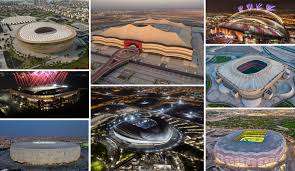
What can unquestionably be regarded as the most contentious FIFA World Cup tournament ever to be staged, will kick off later this month for four weeks of the “beautiful game” against a backdrop of continuing criticism from media outlets, human rights groups, and so called sports experts.
They each have contrasting disputes, but a common agreement between them all is that the competition should not be being held in the tiny middle eastern State of Qatar, who controversially secured the rights to host this years finals, way back in 2010.
Amongst the many issues that have been raised are the local climate, high costs, their lack of football history, and the appalling human rights record. However, probably the strongest negative points raised of all centre around the suggested bribery and corruption that went on, prior to the announcement that the Qataris had been successful in their bid.
Suspicion surrounds the awarding of the tournament
There certainly seems to be a lot of blame avoidance going on and what is known is that more than half of the individuals involved in the voting processes for both the 2022 competition and the previous tournament held in Russia back in 2018, have been accused of wrongdoing, although not necessarily all criminally charged, and that list crucially includes the former FIFA president Sepp Blatter, whose time as leader was constantly under suspicion.
And so it begins
Nevertheless, they did win the vote and twelve years on, and after the tragic loss of life of many migrant workers – who were tasked with building the stadia where the games are to be played, in shocking working conditions – the moment has arrived and the spectacle is about to begin. Starting proceedings are the host nation who have an opening fixture against Ecuador on Sunday 20 November, followed by the rest of the competing countries, who will be challenging each other in eight groups of four teams, with the top two of each progressing into the later stages, culminating in the World Cup Final, which is scheduled for Sunday 18 December.
Temperatures could play a leading role
One of the very real concerns is the weather in Qatar, which is why the tournament is being played in November and December for the first time, as opposed to the middle of the summer, when every other World Cup has taken place.
Temperatures would have been unbearable earlier in the year, and even now it is likely to be uncomfortably hot, with the early group games likely to be played in highs of between 28-30°C, but cooling a little to around 25°C for the knockout stages. The initial matches are being spread over four different kick off times: 13:00, 16:00, 19:00 and 22:00 (local time), so naturally those with an afternoon start are going to find it the most difficult.
Humidity also a major factor
Also, the period that the entire competition is being held in, is actually the most humid on average in Qatar over the course of a year, with a relative average humidity of 71 percent in December, compared to the annual average in the country which is 59 percent. Naturally these numbers will be even higher within the stadiums, so to alleviate this a little, all the grounds have been created with state-of-the-art air conditioning inside them.
State-of-the-art air conditioning to solve the problem… hopefully
Although concerns have been raised over the ability of coolant machines to substantially bring down the temperature in open-air stadiums, each venue has been equipped with specially designed cooling units. The advanced technology was formulated in coordination with the Qatar University using solar energy to power fans, which will filter outside air and cool it significantly, as well as cleaning it; thus giving it the full purification treatment.
Pre-cooled air will enter through grills built into the stands and large nozzles alongside the pitch. Using the air circulation technique, cooled air is then drawn back, re-cooled, filtered and pushed out where it is needed. With this process in operation, temperatures inside the stadiums are expected to hover around a much more manageable 21°C.
Just eight stadiums to be used across entire tournament
The eight grounds, all stunning in design, are situated within a 27-mile radius of central Doha, the Qatari capital, and will be linked by a modern metro system. This will mean that potentially for the first time, fans will be able to attend more than one fixture in a single day, should they so wish.
One of the venues is made up of 974 shipping containers; others have specific designs to represent middle eastern traditions, and quite controversially, one has infamously been likened to a female’s private parts. The list of 8 arenas is as follows: Al Bayt Stadium, Khalifa International Stadium, Al Thumama Stadium, Ahmad Bin Ali Stadium, Lusail Stadium, Stadium 974, Education City Stadium, and Al Janoub Stadium.
Lusail Stadium
This is the show-piece stadium which will be the venue for the World Cup Final. It has an 80,000 capacity and is situated just 10 miles outside of Doha in the new £33 billion city of the same name, and dominates the skyline.
This futuristic creation has a shape and façade that mirrors the intricate decorative motifs found across the Arab and Islamic world, and at night an advanced lighting system will imitate the glow of a fanar lantern. Once the tournament is over most of the seats will be removed and donated to developing countries.
There will be ten matches played in total in the magnificent arena, with six from the group stages featuring amongst others: Argentina, Brazil, Mexico and Portugal. There will also be a last 16 game, a quarter-final, and a semi-final, before it plays host to the conclusion of the competition and the crowning of the trophy winners.
Al Janoub Stadium
This is one of the smaller stadiums with a capacity of 40,000 and has a controversial design that is inspired by the sails of the dhow pearl fishing boats which are traditional to Qatar, in recognition of its maritime heritage. It was designed by a British-Iraqi architect, Dame Zaha Hadid, who died suddenly of a heart attack in 2016, aged 65. She was angered when her drawings were first seen and comparisons were made to a females private parts.
The 92 metre retractable roof is made from plastic PTFE materials and cables, and sits 50 metres above the pitch. Located in the tourist hotspot of Al Wakrah, it is surrounded by beaches and hotels and is equipped with a 5G network signal. It was the first of the new World Cup stadiums to be completed back in the summer of May 2019. There will be six group matches played here with Cameroon and Australia featuring twice each, as well as appearances from the French and Danes. There will also be one last 16 contest.
Al Bayt Stadium
This ground is the furthest from Doha, yet still only 27 miles away giving a clear indication of the close proximity of all the stadiums to the country’s capital. Holding 60,000 this will be where the tournament gets under way on Sunday 20 November, when the host nation entertain Ecuador.
The design from the outside at least, looks the least like a football ground, bearing more of a resemblance to a very large circus tent; indeed it was intentionally built to look like a traditional Bedouin tent called a Bayt al sha’ar. Inside however, it is spectacular, and is another with a retractable roof, this one weighing in at 1,600 tons, yet it can open and close in less than 20 minutes. The venue has a luxury five-star hotel on its doorstep and a huge shopping mall alongside. At the conclusion of the tournament the entire upper level of approximately 28,000 seats, will be dismantled to go to developing countries.
Some of Europe’s heavyweights will play here in the group stages, including a mighty clash between the Spanish and the Germans; plus a meeting between the hosts and the quietly-fancied Netherlands. England will also play one of their games here against the USA, and should they be successful in winning their Group B, then any further progress in the competition through the knock-out stages of a last 16 game, a quarter-final, and a semi-final, will all be achieved in matches scheduled to be played at this impressive stadium.
Ahmad Bin Ali Stadium
With its proximity next to the desert, this 40,000 capacity arena will have hospitality areas and merchandise stalls outside the ground, which will be shaped to resemble sand dunes to blend in with the intricacies in the façade, which reflect Qatari culture. It was actually built on the site of the old ground with the majority of construction materials reused in its erection.
It has a relatively uniform appearance, so not quite so visually stunning as some of the others, but ultra-modern nonetheless. In keeping with many of the eight venues being used, the upper tier of the ground will be dismantled and the seats will be handed over to other sports venues in Qatar and abroad, when the tournament finishes.
It is here that Wales will begin their campaign against the USA, and also where they will play their final and potentially crucial group game against England. The Japanese and Belgians will also play a fixture in this stadium, with one last 16 tie scheduled here too.
Education City Stadium
Although relatively small in comparison with some of the other venues (capacity 40,000), this is a real triumph in design. It is part of Doha’s immense education complex – hence the name and home to eight branch campuses of some of the world’s most prestigious universities.
This fabulous stadium’s enclosed outer shell takes the shape of a diamond and will be nicknamed “the diamond in the desert”. It is designed to be highly reflective so as to glisten by day, when the movement of the sun will animate its appearance, creating an illusion of constant motion; whilst at night with it being illuminated with thousands of diodes, it will glow in a spectacular fashion.
Photovoltaic panels are embedded into the cladding, providing up to 20% of match-day power, and on non-event days the stadium will supply nearby facilities with their electricity. The entire project has been awarded Five-Stars under the Global Sustainability Assessment System (GSAS), making it the first stadium in the world to achieve such recognition, with over 50 per cent of the materials used coming from sustainable sources, and as much as 28% of construction materials being recycled contents.
After the tournament it is set to become the home of the national women’s team. The likes of France, Denmark, South Korea, Saudi Arabia, Uruguay, and the African pair of Tunisia and Ghana will all get to sample the delights of this magnificent arena. A last 16, and a quarter-final will also take place here.
Al Thumama Stadium
A stunning build, this stadium really does have a middle eastern flavour about it. The eye-catching design is inspired by the ‘gahfiya’, a traditional woven cap worn by men across the region, and it is instantly identifiable. One of the smaller capacities at 40,000 it actually looks more like an entertainment venue from the outside.
It is located in the district of the same name in the south-western part of Doha, just 8 miles from the very centre. This is another that will half its capacity after the World Cup, by donating seats from its upper tier to developing countries. There is a mosque, a sports clinic and a 60-room boutique hotel, also on the site.
Until just a month or so ago this was to be the venue for the opening fixture of the tournament between the Dutch and Senegal, until Qatar’s game was moved back 24 hours. Others who will play here include Belgium, Spain, Costa Rica, Canada, Iran, USA, and Morocco twice. There will also be a last 16 and a quarter-final decided at the arena.
Stadium 974
This is unquestionably the quirkiest of all the eight grounds; it has actually been made from 974 shipping containers (974 is also Qatar’s international dialling code) and other materials, which can be dismantled at the tournament’s end, with the intention of reducing waste and emissions. It holds 40,000 seats, divided into two levels, and is just 6 miles from the centre of the capital.
It overlooks the Doha Corniche and the skyline of the West Bay, which is a stunning waterfront promenade that looks amazing once darkness descends on the area. From the outside, the venue gives the impression of being made of huge Lego bricks in a variety of colours. Once the World Cup is over the site will be cleared and turned into green areas.
This is another ground that the French will play at in the group stages, along with other highly fancied countries such as: Brazil and Argentina, together with the likes of Serbia, Switzerland, Poland and Portugal. There will also be a last 16 tie played out in the stadium.
Khalifa International Stadium
This stadium was the only one not purpose-built; it actually opened initially way back in 1976 and previously hosted the Asian Games, the Gulf Cup, the AFC Asian Cup, and the IAAF World Athletics Championships. There have been significant renovations in the years since, leaving it now with a 45,000 capacity, just 8 miles from the centre of Doha.
The most visually stunning aspect of the ground is its cleverly designed roof, which covers 70 per cent of the arena and although not retractable, it has been created to provide sufficient shade for the majority inside. Right next to it is the 980 feet tall Aspire Tower, visible for miles around. This has a revolving restaurant that gives a magnificent 360-degree view of the city and its surrounds.
It was here just three years ago that Liverpool won the FIFA Club World Cup with Brazilian Roberto Firmino scoring an extra-time winner against Flamengo, a team from his birth country. Ten years prior to that, England had played the Brazilian national side in a friendly, and it is here that they will get their tournament underway on 21 November, in a fixture with Iran.
The stadium will entertain a variety of other nations through the group stages, namely: Germany, Japan, Netherlands, Spain, Ecuador, Croatia, Canada, and Senegal. It will then go on to be the venue for a last 16 match, a quarter-final, a semi-final, and also it will be the stadium at which the tournament’s third-place play-off is played.
Inevitable disagreements over legacies
Of the eight stadiums, only one will be called home to a football team afterwards. Indeed, one will be completely dismantled altogether, whilst the remaining six venues will have at least half of their seating removed. What legacies remain at each site will differ significantly, and there will inevitably be arguments on both sides as to whether the immense cost of staging the tournament was actually worthwhile.
When all said and done it is the World Cup… and it’s here
As for the tournament itself, as usual there will be controversies, disputes, tears of joy and despair, hard-luck stories, stars emerging, incredible goals, remarkable misses, fantastic saves, awful refereeing decisions, and moments that will live on in World Cup history.
Above all it will be memorable and exciting for many reasons… and it is almost upon us.












0 Comments